Italian cuisine is undeniably fantastic. Its hard to find anyone who disagrees.. Whats intriguing is the array of delicious regional dishes, in Italy and their unwavering resistance to the homogenized and uninspiring nature of modern commercial food production. You know those meals that try to mask their lack of taste, with excessive sugar and preservatives? Thankfully anthropologists have shed some light on how Italian cooking has evolved or perhaps hasn’t over time.
In her report, for Bloomberg, columnist Megan McArdle discusses how the enduring popularity of cuisine which we all adore is deeply rooted in historical factors dating back to the Roman Empire and the challenging times following the Renaissance era. Despite Italys recovery from struggles its transition, to industrialization was delayed, ultimately benefiting the quality of its food offerings.
The advent of processed food, in societies not only brought about a decrease in food quality but also encouraged women to join the workforce reducing the time they spent cooking nutritious meals, which ultimately led to a decline. As a result nations that embraced modernization on ended up with lower quality cuisine compared to countries like Italy, which lagged behind. This is something some of us may have personally witnessed as our mothers prioritized their careers. While theres nothing, with this shift it did come with consequences.
In Italy food remains deeply ingrained, in its culture and forms a part of its identity. The traditional Italian cuisine is characterized by its wholesome, vibrant and tasty nature. If one is fortunate to have a mother preparing meals, for the family dining out may seem unnecessary.
Today we’re here to share a way to enjoy a meal, with a Montana flavor. All you came here for The Taste of MONTANA. Lets whip up some Ossobuco (a bone, with a hole) using bison shanks sourced from Montanas bison.
Ossobuco the marrow found in bone cavities is considered a delicacy, in Italy. Originally hailing from Lombardy in Northern Italy it bore similarities to Central European cuisines. As it made its way, to Italy the dish underwent adaptations to align with customs and available ingredients eventually embodying the quintessential flavors of Italian cuisine that we all cherish. Embracing tomato based dishes wholeheartedly our lycopene intake remains robust throughout the year.
Cooking ossobuco, to perfection requires patience. Is typically accompanied by gremolata served alongside either risotto or polenta. The slow cooking method results in an tender meat that easily falls off the bone offering a blend of savory and umami flavors. If you found yourself savoring the dish with a mmm ” you might just unknowingly slip into an accent or perhaps even fancy yourself as a Montana native if you opted for bison meat, in the recipe. Yes that’s right. I said quasi.
Ingredients
- 3 lbs. bison bone-in shanks
- Flour for dusting
- Kosher salt
- Freshly ground black pepper
- 2 TBSP olive oil
- 2 medium onions sliced
- 2 medium carrots sliced
- 2 celery stalks sliced
- ½ cup red wine
- 6 cloves garlic minced or pressed
- 1 28-ounce can of diced tomatoes, undrained
- 1½ cups beef stock
- 1 tsp dried thyme
- 1 tsp dried oregano
- 1 tsp dried basil
- 1 bay leaf
- Crushed red pepper to taste
- ¼ cup parsley chopped
- Parmesan cheese
- 1 lemon cut into wedges
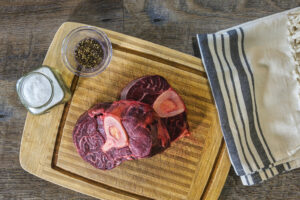
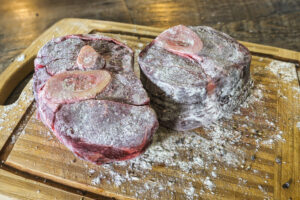
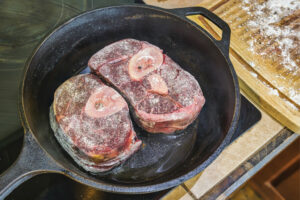
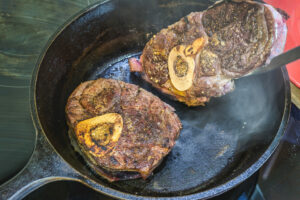
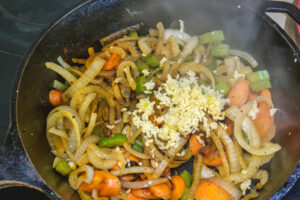
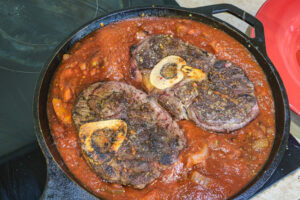

Instructions
- Preheat the oven to 350°F.
- Gently pat dry the bison shanks. Season them on both sides, with salt and black pepper. Next lightly coat them with flour.
- Start by heating a Dutch oven on the stovetop, at heat then pour in the olive oil. Next sear the bison shanks on all sides until they turn brown which should take 3 minutes, per side. Once done take out the browned shanks. Place them aside.
- Put the onions, carrots and celery in the oven. Cook them until they are slightly soft which should take around 4 to 5 minutes. Pour in the wine. Scrape all those tasty bits, from the bottom of the pan while stirring.
- Add in the garlic tomatoes, beef broth, thyme oregano, basil, a bay leaf. Crushed pepper. Let it simmer gently.
- Put the shanks back, in the pan. If necessary, pour, in beef broth to ensure the shanks are fully submerged. Cover with a lid and transfer to the oven. Remember to brush the bison shanks with juices every 30 minutes and flip them through ( 1½ hours). Cook until the meat is soft and easily comes off the bone.
- To plate the dish take out the bison shanks. Arrange them on plates. Drizzle the sauce, from the pot over the shanks then sprinkle with parsley, Parmesan cheese and a slice of lemon, for a finishing touch.

I spent a good bit of my 20’s touring the country playing music. As a teenager, and throughout my 20’s, in between music, I always worked in restaurants, in various capacities. Somewhere in my late 20’s I realized that I was not on the cover of Rolling Stone, as planned, and so, I started thinking about my future and trying to figure out other ways to have an impact, be creative and still live a bit of that rock ‘n roll lifestyle. The restaurant industry provided me with a good bit of those things. And so, I started honing my chops in the kitchen, putting my nose in food lover’s companion, and really started to go somewhere with it.